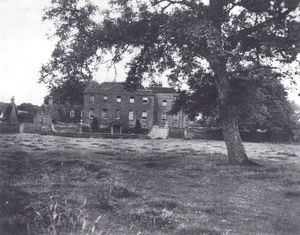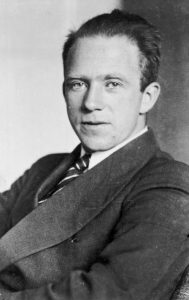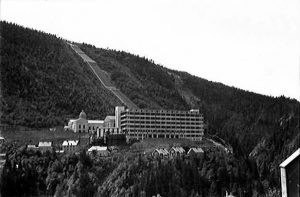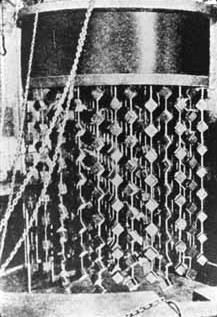“I don’t believe a word of the whole thing,” declared Werner Heisenberg, the scientific head of the German nuclear program, after hearing the news that the United States had dropped an atomic bomb on Hiroshima.
Germany began its secret program, called Uranverein, or “uranium club,” in April 1939, just months after German scientists Otto Hahn and Fritz Strassmann had inadvertently discovered fission. Germany had a significant head start over the Manhattan Project as well as some of the best scientists, a strong industrial base, sufficient materials, and the interest of its military officers. Nevertheless, the reaction of Heisenberg illustrates just how far the German program came from actually developing a nuclear weapon.
A “Race” for the Bomb
The United States government became aware of the German nuclear program in August 1939, when Albert Einstein wrote to President Roosevelt, warning “that it may become possible to set up a nuclear chain reaction in a large mass of uranium by which vast amounts of power and large quantities of new radium-like elements would be generated.” The United States was in a race to develop an atomic bomb believing whoever had the bomb first would win the war.
Robert Furman, assistant to General Leslie Groves and the Chief of Foreign Intelligence for the Manhattan Project, described how “the Manhattan Project was built on fear: fear that the enemy had the bomb, or would have it before we could develop it. The scientists knew this to be the case because they were refugees from Germany, a large number of them, and they had studied under the Germans before the war broke out.” Manhattan Project physicist Leona Marshall Libby also recalled, “I think everyone was terrified that we were wrong, and the Germans were ahead of us.… Germany led the civilized world of physics in every aspect, at the time war set in, when Hitler lowered the boom. It was a very frightening time.”

The United States government remained equally afraid. General Groves remembered, “Unless and until we had positive knowledge to the contrary, we had to assume that the most competent German scientists and engineers were working on an atomic program with the full support of their government and with the full capacity of German industry at their disposal. Any other assumption would have been unsound and dangerous” (Norris 295). There was even consideration of kidnapping Werner Heisenberg in Switzerland in 1942, although this plan never came to fruition. In 1943, the United States launched the Alsos Mission, a foreign intelligence project focused on learning the extent of Germany’s nuclear program.
By 1944, however, the evidence was clear: the Germans had not come close to developing a bomb and had only advanced to preliminary research. Following the German defeat, the Allies detained ten German scientists, at Farm Hall, a bugged house in Godmanchester, England, from July 3, 1945 to January 3, 1946. Some of them, such as Heisenberg, Kurt Diebner, and Carl von Weiszacker were directly involved in the project, while others, such as Otto Hahn and Max von Laue, were only suspected and later proven to have not been involved. Heisenberg’s disbelief after hearing that the United States had dropped an atomic bomb on Hiroshima confirmed in the minds of the Allies that the German effort was never close. As one German scientist exclaimed, it must have taken “factories large as the United States to make that much uranium-235!”
Systemic Disorganization

The Manhattan Project was characterized by an incredible coordinated effort between science, government, and industry. This was simply not the case with the German project. While being held at Farm Hall, physicist Horst Korsching noted, “the Americans are capable of real cooperation on a tremendous scale.” He added, however, that it “would have been impossible in Germany. Each one said that the other was unimportant.” Furthermore, to be successful would have required an enormous logistical and financial push, as in the United States. The German government ultimately decided that with the uncertainty surrounding the bomb project, it was not worth the gamble.
The German project had fundamental flaws from its conception. Many top German scientists had left Germany, some of them Jewish émigrés fleeing the new laws of German National Socialism. Other scientists left in protest, significantly decreasing the number of experts available to work on a German bomb. A substantial number eventually came to the United States to work on the Manhattan Project. The bigger problem, however, lay in lack of support. Hitler was much more interested in developing the V-2, a long-range ballistic missile. After later hearing a 1942 lecture given by Heisenberg to scientists and government officials, Hans Bethe remarked, “My first reaction is that Heisenberg knew a lot more than I have always thought – the fact he reached many of these conclusions in one evening is most remarkable. In his lecture it was clear he was talking to people who were quite ignorant… Apparently the other people didn’t know very much about fission…” (Powers 451).
Another problem was coordination among different departments. To begin with, communications between different areas were extremely poor. In a 1942 meeting with Albert Speer, the Minister of Armaments and War Production, Heisenberg made a reference to the amount of U-235 necessary and caused a small sensation when he used the word “bomb” – many of the scientists and officials present were not aware that this was actually possible. The Farm Hall transcripts also show the ignorance of Walther Gerlach, the scientific liaison to the German government, an important link in coordinating the project.
Furthermore, Speer was reluctant to bring up the bomb project with Hitler himself unless he could produce clear results. This led to misinformation and misunderstanding, seen clearly when Hitler suggested to Speer that the bomb “would throw a man off his horse at a distance of over two miles” (Powers 151). Heisenberg’s frustrations were evident when, at Farm Hall, he remarked, “The point is that the whole structure of the relationship between the scientist and the state in Germany was such that although we were not 100% anxious to do it, on the other hand we were so little trusted by the state that even if we had wanted to do it, it would not have been easy to get it through.”
Significant work on the German project was halted in June of 1942. The Germans never achieved a successful chain reaction, had no method of enriching uranium, and never seriously considered plutonium as a viable substitute. Heisenberg recalled in his memoir, “The government decided that work on the reactor project must be continued, but only on a modest scale. No orders were given to build atomic bombs” (Powers x). Speer later noted, “We got the view that the development was very much at the beginning… the physicists themselves didn’t want to put much into it” (Powers 479), and that “the technical prerequisites for production would take years to develop, two years at the earliest, even provided that the program was given maximum support” (Rhodes 404). German resources were allocated to other priorities.
The timing of this cut fits with the pressures Germany faced in the war at the time, as resources had to be allocated to the immediate war effort. The director of the Reich military research asserted, “The work… is making demands which can be justified in the current recruiting and raw materials crisis only if there is a certainty of getting some benefit from it in the near future” (Rhodes 402).
Allegations of Sabotage
A popular theory for the failure of the German project is that Heisenberg deliberately aborted it so that Hitler would not have the atomic bomb. But there remains little evidence of this. Heisenberg’s 1941 meeting in Copenhagen with Niels Bohr, who would later work on the Manhattan Project, was dramatized in the 1998 play Copenhagen. The play explores three scenarios where Heisenberg discusses his dilemma with Bohr, but leaves the matter for audiences to decide what Heisenberg actually believed and intended to do.
Nevertheless, different accounts of this meeting suggest otherwise. Heisenberg’s wife Elizabeth described a “vague hope” that Heisenberg had to halt bomb development in the United States by passing reassurances through Bohr. Victor Weisskopf recounted Bohr telling him, “Heisenberg wanted to know if Bohr knew anything about the nuclear program of the Allies. He wanted to propose a scientists’ decision not to work on the bomb, and he wanted to invite Bohr to come to Germany to establish better relations” (Powers 125).
Heisenberg did however tell Bohr that the German project was underway, and drew a simple sketch, which Bohr thought to be a bomb. Infuriated by Heisenberg, who he thought “is not being honest, or he is being used by the Nazi government,” Bohr refused to speak with him more and eventually turned the sketch over to Manhattan Project scientists, who identified it as the outline of a reactor (Powers 126). J. Robert Oppenheimer later recalled, “Bohr had the impression that they came less to tell what they knew than to see if Bohr knew anything that they did not; I believe it was a standoff.” As his son Aage Bohr explained, “He had the impression that Heisenberg thought that the new possibilities could decide the outcome of the war if the war dragged on” (Rhodes 385).
Despite some misgivings about building a bomb, throughout the war Heisenberg maintained a genuine loyalty to his country. Richard Rhodes recalled, “There was at least one speculation that one of the German scientists deliberately falsified the measurements in graphite, hoping to stop a German bomb program. I don’t think there’s really evidence to support that. It seems to have been a mistake in the course of developing these various components of the technology.” Historians generally agree that the problems with the German project stemmed from serious miscalculations and a lack of priority. The allegations of sabotage carry little weight.
The Norwegian Heavy Water Plant
 Heisenberg’s efforts were derailed in part by his decision to use heavy water instead of graphite as a “moderator” to slow and control the fission process. Following their invasion of Norway in 1940, the Germans assumed control of the Norsk Hydro heavy water plant at Vemork. Not only was heavy water a less effective moderator than graphite, it made the German program reliant on the Norwegian plant.
Heisenberg’s efforts were derailed in part by his decision to use heavy water instead of graphite as a “moderator” to slow and control the fission process. Following their invasion of Norway in 1940, the Germans assumed control of the Norsk Hydro heavy water plant at Vemork. Not only was heavy water a less effective moderator than graphite, it made the German program reliant on the Norwegian plant.
Fearing that the Germans would use the heavy water for their atomic bomb program, Allied forces conducted a series of strategic bombings against the plant. Finally, on February 28, 1943, a Norwegian commando raid destroyed the facility’s heavy water section in Operation Gunnerside, resulting in the loss of 500kg of heavy water. Joachim Ronneberg, the leader of the commando team that blew up the plant, recalled, “There were so many things that were just luck and chance. There was no plan. We were just hoping for the best.” He also asserted that if the mission had failed, London could have “ended up looking like Hiroshima.”
While the Germans later rebuilt parts of the plant, it remained the target of Allied bombings and never returned to its full operational capacity. The Allied bombing of the plant was dramatized in the 2015 TV miniseries “The Heavy Water War” by the Norwegian Broadcasting Corporation.
Historical Legacy
Although it is now clear that the German nuclear program never came close to producing a bomb, there is no doubt that it provided an impetus for the Manhattan Project. Often forgotten in the wake of Hiroshima and Nagasaki is that the Manhattan Project was originally conceived for the war in Europe, but the bomb was not ready for operational use in time. Historians continue to debate what would have happened had the Germans invested significant resources in their nuclear program, and if it could have changed the outcome of the war.
As part of the agreement that allowed West Germany to become a member of NATO under a revised Brussels Treaty, West Germany promised not to develop any chemical, biological, or nuclear weapons. Despite this, nuclear weapons would eventually be deployed in both West Germany and East Germany by the United States and the Soviet Union respectively. After the breakup of the Warsaw Pact, the United States removed the majority of its nuclear arsenal from Europe. Germany today is officially an “undeclared nuclear state,” as it remains the recipient of NATO’s nuclear sharing, most recently with the deployment of twenty new B61 tactical missiles in 2015. Nevertheless, German politicians have continued to assert that their eventual goal is the “withdrawal of tactical nuclear weapons stationed in Germany and Europe.”





